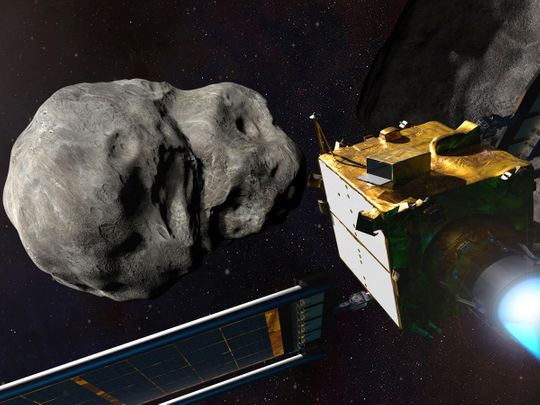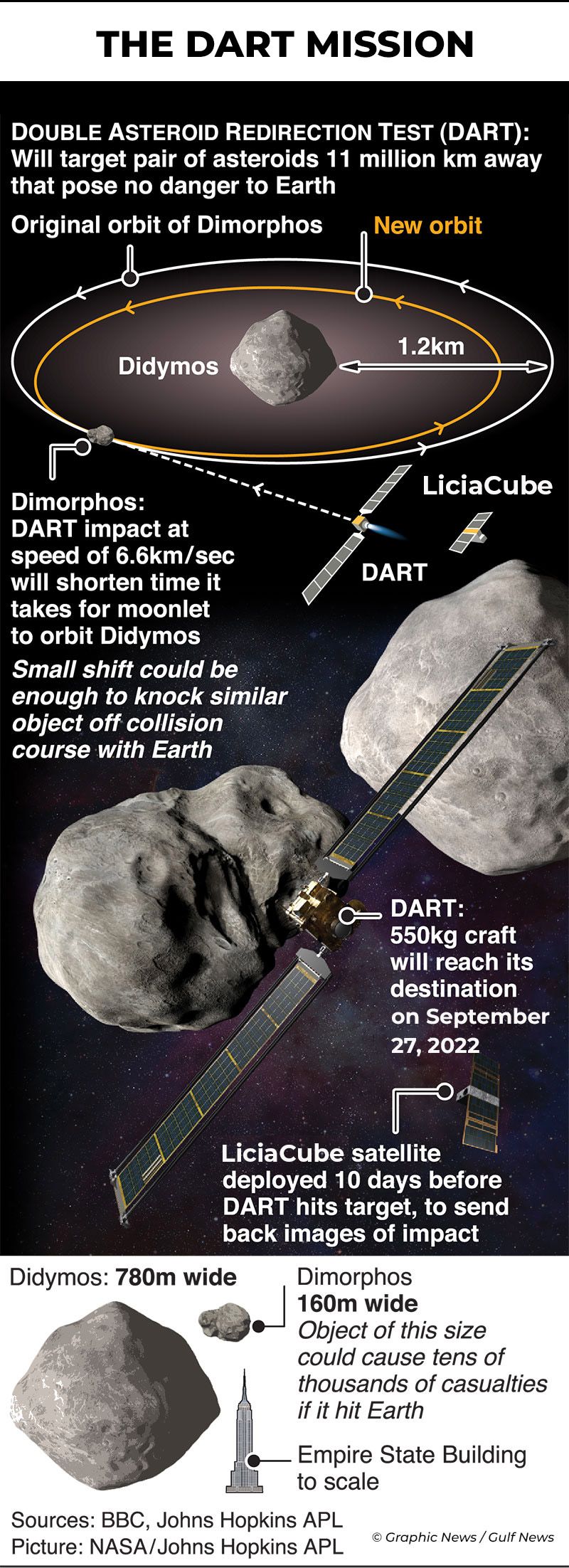
Remember the movies Armageddon, Deep Impact, Meteor and Don’t Look Up? These are some films on asteroids that threaten to smash into Earth as scientists attempt to steer their course. Nasa is trying something similar with the DART mission, although its target, asteroid Dimorphos, poses no threat to Earth. But it’s the distant possibility of such catastrophes that spurs such experiments.
When asteroid Chicxulub struck more than 66 million years ago, it destroyed 75 per cent of living beings on Earth. It reshaped life on our planet and ushered in the age of mammals. Scientists at Nasa’s Centre for Near Earth Objects, who track around 30,000 asteroids and comets that pass close to Earth’s orbit, say that our planet is not in immediate danger of another calamity like the one that wiped out dinosaurs.

That hasn’t lulled researchers into complacency. Nasa has been working on a planetary defence system that will enable scientists to redirect a space object that threatens Earth. A spacecraft, called the Double Asteroid Redirection Test (DART), is part of the defence system that will be put to the test on Tuesday (September 27) at 3.14pm UAE time in an attempt to change its trajectory.
Here’s what we know of the experiment.
What’s DART?
The 570kg Double Asteroid Redirection Test (DART) spacecraft has a single instrument: a camera used for navigating, targeting and chronicling the collision. The $330m probe will also carry LiciaCube, a 14kg Italian CubeSat, to record DART’S crash from a safe distance of 50km, and beam the pictures to Earth.
What’s LiciaCube?
LiciaCube is a 14kg Italian CubeSat carried by DART and released around 10 days ago to record DART’S crash from a safe distance of 50km and beam them to Earth.
“LiciaCube will pass about three minutes after DART’s impact,” BBC News quoted Simone Pirrotta from the Italian space agency (ASI) as saying. “This timing has been selected in order to allow the plume of ejecta to be completely developed because one of the major contributions of LiciaCube is to document the plume to support the measurement of the parameters that confirm the deflection of the orbit.”
What is the DART mission?
A group of scientists and engineers led by the Johns Hopkins University Applied Physics Laboratory are attempting to smash the DART spacecraft into asteroid Dimorphos at a mindboggling speed of 22,015 kph in a bid to change its trajectory. The results will help scientists understand if potentially dangerous space rocks can be diverted before they reach the Earth.
The spacecraft is due to slam into the asteroid about 11 million kilometres above the Indian Ocean. The impact at nearly seven kilometres a second will destroy the half-tonne probe but will yield data that will help scientists to stave off the threat of near-Earth objects.
What do we know of the asteroid Dimorphos?
Asteroid Dimorphos is 160 metres wide and orbits a larger, 2,780-metre asteroid called Didymos, Greek for twin. Such a system, where one asteroid orbits the other, is called a binary asteroid. Dimorphos orbits its parent body at a distance of less than 1.2km. Based on the light reflected from Didymos, discovered in 1996, scientists believe the asteroid is made chiefly of silicate-rich rocks.
“Dimorphos is small enough that it hasn’t actually been studied separately from Didymos in any great detail. We know that it’s a separate body, but we know very little about the shape. We don’t know if Dimorphos is elongated or spherical; we don’t know whether it’s a single rock or a pile of boulders,” Terik Daly, a deputy instrument scientist on DART’s Didymos Reconnaissance and Asteroid Camera for Optical navigation (DRACO), told Space.com.
Why was Dimorphos chosen?
Nasa says the binary asteroid was picked since there’s a zero chance the asteroid Dimorphos or its parent Didymos will be a threat to Earth in the future.
How challenging is the mission?
Hitting Dimorphos is a significant challenge since DART can distinguish its target from the bigger Didymos only 50 minutes before the collision. On Monday night, mission controllers will hand control to DART’s navigation software which will steer the spacecraft for a direct hit.
“It’s a very complicated game of cosmic billiards,” said Prof Alan Fitzsimmons, an astronomer and member of the Nasa DART investigation team at Queen’s University Belfast, told the Guardian.
“Because of the speed of light and the distances involved, it’s really not feasible for there to be a pilot sitting on the ground with a stick controlling the spacecraft. There just isn’t enough time to respond,” said Dr Tom Statler, the DART programme scientist at Nasa.

How will the crash be captured?
As DART hurtles towards the surface of Dimorphos, the spacecraft will transmit images at the rate of one per second from its DRACO camera. The collision at 3.14am UAE time on Tuesday (12.14am UK time) will be recorded by DART’s camera and two other cameras onboard a small Italian probe called LiciaCube, which DART released last week to witness the crash from a safe distance.
“We’ve had to develop software that can interpret images taken by the spacecraft, figure out what is the right target and make the course correction manoeuvres by firing thrusters,” Statler said.
Can the crash be seen from Earth?
Telescopes from Earth will be watching, along with the Hubble and James Webb space telescopes and Nasa’s asteroid-hunting Lucy spacecraft. They will likely see a bright flash as DART smashes into Dimorphos and sends streams of rock and dirt into space.
Will the DART change asteroid’s path?
The results from the crash will tell us whether there has been any change in the asteroid path after the DART crash. Currently, Dimorphos takes around 11 hours and 55 minutes to circle Didymos. The impact is expected to reduce the orbital period to around 11 hours and 45 minutes.
“DART is the first planetary defence test mission to demonstrate running a spacecraft into an asteroid to move the position of that asteroid ever so slightly in space,” Nancy Chabot from the Johns Hopkins APL told BBC News.
“This is the sort of thing, if you needed to, that you would do years in advance to just give the asteroid a small nudge to change its future position so that the Earth and the asteroid wouldn’t be on a collision course,” she added.
How will scientists measure the impact?
The observatories on Earth will track the pair of asteroids as they circle the sun to see if DART altered Dimorphos’ orbit. In 2024, the European Space Agency will send three spacecraft — collectively known as the Hera mission — to retrace DART’s journey to Didymos and Dimorphos and measure the impact results.
Will the mission help avert space rock collisions in future?
The DART test will provide evidence on whether a crash can alter an asteroid’s trajectory. It will also help scientists develop systems or programmes to divert potentially dangerous space rocks before they endanger the Earth.
Even if DART misses, the experiment still will provide valuable insight, Andrea Riley, programme executive at Nasa, said. “This is why we test. We want to do it now rather than when there’s an actual need,” she added.










